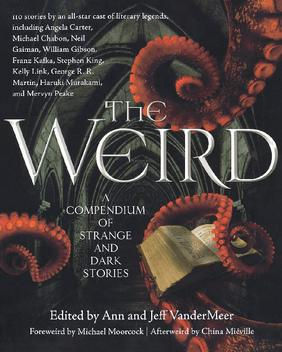The Weird, Various, Ann and Jeff VanderMeer - a review
- carmillavoiez

- Jan 8, 2019
- 3 min read

The most unique aspect of this book is the breadth and length of the collection. At 750,000 words it’s about the length of ten novels and it includes work that crosses genres including horror, fantasy, sci-fi and literary fiction. There are over a hundred short stories included so I will only mention my favourites in this review, but believe me when I say there is something for everyone.
Included in this tome is work by authors such as George R R Martin, Franz Kafka, Ray Bradbury, Octavia Butler, Shirley Jackson, Mervyn Peake, Daphne Du Maurier, Haruki Murakami, Tanith Lee and Neil Gaiman. Perhaps because of the scope of the book it has problems with editing and formatting, but these aren't so terrible as to ruin the experience.
Hanns Heinz Ewers, The Spider, 1915 (translation, Germany)
This was an incredible story. Although clues and signposts are set out carefully from the start its conclusion remains a revelation. The skill involved in such a balancing act amazes me.
Bruno Schulz, Sanatorium at the Sign of the Hourglass, 1937 (translation, Poland) is an absolute nightmare of hate and fascism.
Leonora Carrington, White Rabbits, 1941, includes carnivorous rabbits and lepers with skin like stars.
Donald Wollheim, Mimic, 1942, within which insects pass as human.
Ray Bradbury, The Crowd, 1943, a famous story that I’ve read before about the conspiracy that surrounds road traffic accidents.
Jerome Bixby, It’s a Good Life, 1953
Is a tale of Anthony, a boy who can alter reality with his thoughts, and the terrified people who have to find ways to navigate each interaction with him.
William Sansom, A Woman Seldom Found, 1956, a strange tale full of gorgeous description and with a dramatic ending.
Charles Beaumont, The Howling Man, 1959
A tale of gas lighting and the malleability of our reality. A rich man takes ill in Europe and recovers in a monastery where he encounters a howling man who the monks deny exists.
Mervyn Peake, Same Time, Same Place, 1963
The monotony of family life drives a young man in search of adventure. The story is about falling in love with the idea of someone rather than an actual person. When he is confronted with the reality of this romantic ideal the man retreats to his family and embraces the monotony he tried to escape.
Merce Rodoreda, The Salamander, 1967 (translation, Catalan)
A woman tortured for her sexuality has her body broken and pieces of it stolen for the entertainment of others.
Daphne Du Maurier, Don’t Look Now, 1971
Another famous story that I’ve read before. Although it is less weird than most of these stories it is beautiful and satisfying to read.
James Tiptree Jr. (Alice Sheldon), The Psychologist Who Wouldn’t Do Terrible Things to Rats, 1976
Part horror, part fairy tale this is a story about a reluctant experimenter who doesn’t want to hurt the animals in his care but feels pressured to do so. In an encounter with King Rat the psychologist loses the best part of his nature.
George R.R. Martin, Sandkings, 1979
Hive minded creatures worship their owners as gods. A wonderful parable about the importance of benevolence.
Octavia Butler – Bloodchild, and Clive Barker – In the Hills, the Cities, are two more beautiful stories that I have read before, elsewhere. One is about alien reproduction and the other about giants built from people.
Leena Krohn, Tainaron, 1985 (translation, Finland)
A city where insects are the dominant species, not only in numbers but as leaders. The letter writing narrator strives to understand their habits, motivations and political structures.
Lisa Tuttle, Replacements, 1992
The tale of a husband who feels usurped in his wife’s affections by a vampiric pet.
Marc Laidlaw, The Diane Arbus Suicide Portfolio, 1993
A story that plays with the idea that photographs can trap the subject’s soul.
Brian Evenson, The Brotherhood of Mutilation, 2003
A thriller based in a society where the power hierarchy is structured based on the number and severity of amputations.
Daniel Abraham, Flat Diane, 2004
A disturbing and sad story about how abusing the image of another person can have enormous implications.
It is likely that you will find your own favourites among the 110 tales. What delights me most about this book is the attention paid to chronology, biographies and seminal works.
I probably only enjoyed half of the stories, but those I enjoyed so much that it did not upset me to skip those tales that held no appeal.
4.5/5 stars.




Comments